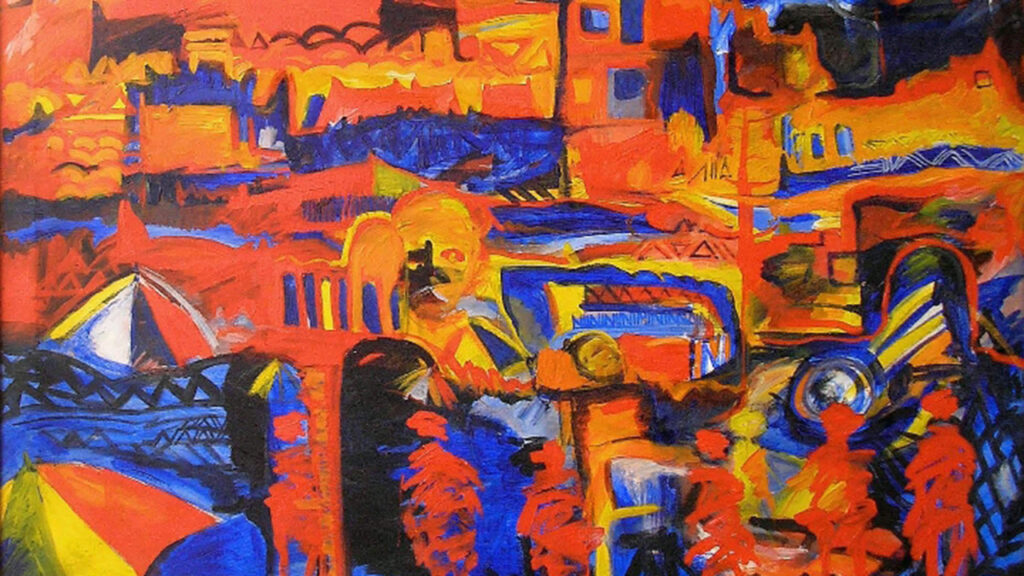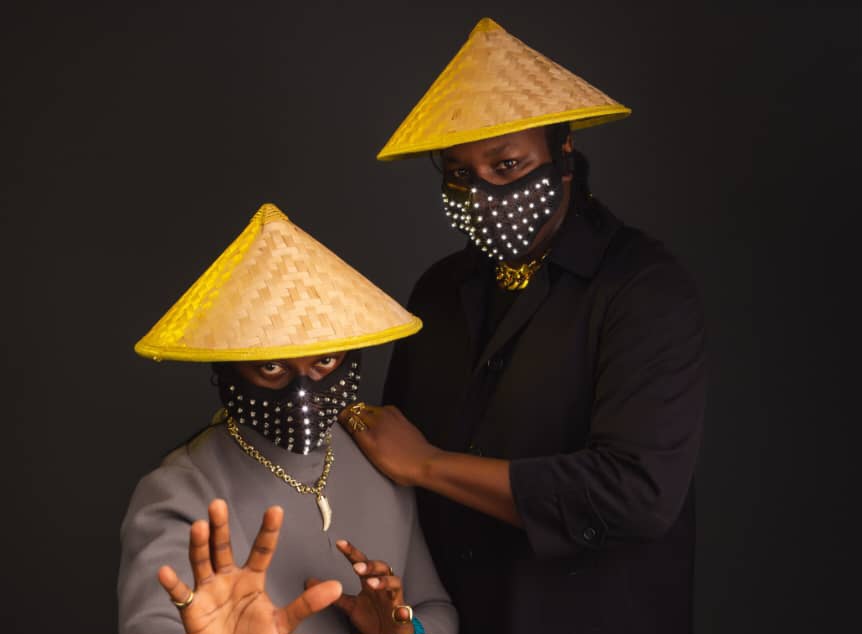
Joseph Alufa Igbinovia is not a celebrity, who will glide through crowds of tourists and local revelers astride an elaborate float of the Edo regalia. He is one of the artists who will rather concentrate on their work than make noise about.
But strangely, he is not one of those Dr. Simon Ikpakronyi, Director of Curatorial Services at the National Gallery of Art (NGA), described as “popular modern Benin artists” such as Osagie Osifo, Ben Aye, Ben Osawe, Erhabor Emokpae, Felix Idubor, Festus Idehen, Ovia Isah, Robert Odiaseh, Rowland Ogiamien and Amos Odion.
Some of these artists, who emerged in the 1960s, Ikpakronyi explains, had their training in Nigerian universities, some overseas, after which they set up studios, mostly in Lagos, where they practised and trained others.
“They earned international reputation and received commissions from public and private patrons, art galleries, brokers, architects, universities and so on. Many of them hailed from traditional backgrounds and were original souvenir carvers who later achieved international recognition, especially for their carved wood doors for government and private organisations.”
The 73-year-old man is a sculptor, carpenter, welder and carver. At the oba’s palace, he is a chief and one of the celebrated carvers in the land. He is a member of Iwebo Palace Society. Iwebo was established by the Oba of Benin for grooming those that want to become chiefs in the kingdom and those providing services such as carvers, bronze casters and iron potters. The head of the carvers is known as Ukoniwebo.
Alufa is an Ukoniwebo, a status he attained during the reign of Omo N’Oba N’Edo Uku Akpolokpo, Oba Erediauwa, Oba of Benin Kingdom after many years of dedicated service to the Oba.
Surprisingly, Alufa is not from Igbesanmwan, the known carving community of Benin. He just went there for apprenticeship. By 1976, he was already a mature artist. He had carved two works, Imedumiran, and Olokun Obaramen, a 7-ft high work, which established him as a master carver. These two works brought him fame that actually drew him closer to his dream carving: Queen Idia mask — The symbol of Second World Black and African Festival of Arts and Culture, FESTAC ‘77.
The masks were made around 500 years ago by the carvers’ guild. These masks and more than 3,000 other works — and perhaps thousands more as well — were stolen by invading British soldiers in 1897, 125 years ago, and are now treasured pieces in the collections of some of the most important museums in the United States and Europe.
The Benin invasion of 1897 was a punitive expedition by a British force of 1,200 men under Sir Harry Rawson in response to the ambush of a previous British party under Acting Consul General James Phillips.
Rawson’s troops captured and sacked Benin City, bringing to an end the kingdom, which was eventually absorbed into colonial Nigeria. On February 9, 1897, the invasion of the Kingdom of Benin began. The British invasion force of about 1,200 Royal Marines, sailors and Niger Coast Protectorate Forces was organised into three columns: the ‘Sapoba’, ‘Gwato’ and ‘Main’ columns. Flotillas of warships (including HMS Philomel and Phoebe) and gunboats approached Benin City from the east and west.
The ‘Sapoba’ and ‘Main’ columns reached Benin City after 10 days of fighting. The ‘Gwato’ column (under Captain Gallwey) took the same route as that taken by the previous mission and came on the scene of the massacre, finding headless bodies of the victims. On February 18, Benin City was captured by the expedition, in spite of its defensive iya. The city was set ablaze, although it has been claimed that this was accidental.
Immediately after the city was captured, widespread looting began. It was an exercise that was carried out by all members of the expedition. Houses, sacred sites, ceremonial buildings and palaces of many high-ranking chiefs were looted and many buildings were burned down, including the Palace building itself on Sunday, February 21.
Most of the plunder from the city was retained by the expedition with some 2,500 (official figures) religious artefacts, Benin visual history, mnemonics and artworks being sent to Britain. They include over a thousand metal plaques and sculptures collectively known as the Benin Bronzes. The Admiralty confiscated and auctioned off the war booty to defray the costs of the expedition.
About 40 per cent of the art was accessioned to the British Museum, while other works were given to individual members of the armed forces as spoils of war, and the remainder was sold at auction by the Admiralty to pay for the expedition as early as May 1897 (Stevens Auction Rooms, 38 King Street, London, May 25, 1897; followed by several sales at William Downing Webster, Bicester, between 1898 and 1900).
Most of the Benin Bronzes sold at auction were purchased by museums, mainly in Germany. The dispersal of Benin artworks to museums around the world catalysed the beginnings of a long and slow European reassessment of the value of West African art.
The Benin art was copied and the style integrated into the art of many European artists and thus had a strong influence on the early formation of modernism in Europe.
Benin bronzes can be found in 161 museums around the world, according to research by Dan Hicks, a curator at the Pitt Rivers Museum at the University of Oxford and the author of “The Brutish Museums.” Thirty-eight are in the United States. Only nine of the institutions are in Nigeria.
The Oba of Benin, Oba Akenzua II, for example, requested, in 1936, and got one regalia back, but this did not signal a change of attitude of the colonial masters. The Western states have regularly ignored the injunction of the world body and continued their illegal possession of the cultural artefacts of their former colonies. This outlaw behaviour of Western states does not seem to bother them.
In 1977, Nigeria requested from Britain the famous ivory hip-mask of Queen mother, Idia, from the British Museum for the pan-African festival (FESTAC 77). After asking for 2 million pounds, Britain declined to lend the mask to Nigeria. The argument advanced by Britain, such as the climatic difference between the British Museum and Nigeria, infuriated all Africans.
In 2017, a cockerel statue or Okukor looted during the 1897 Benin Expedition was removed from the hall of Jesus College, Cambridge, following protests by students of the university.
Jesus College’s student union passed a motion declaring that the sculpture should be returned. A spokesperson from the university stated that “Jesus College acknowledges the contribution made by students in raising the important but complex question of the rightful location of its Benin bronze, in response to which it has removed the Okukor from its hall” and that the university is willing “to discuss and determine the best future for the Okukor, including the question of repatriation.”
On October 27, 2021, the National Commission for Museums and Monuments (NCMM) received the Okukor in a Benin Bronze Restitution Ceremony held and live-streamed by Jesus College.
The University of Aberdeen became the first institution to agree to the full repatriation of a Benin Bronze from a museum in March 2021 and handed back a bronze sculpture, depicting the head of an Oba, to NCMM on October 28, 2021. It had been purchased by the university at an auction in 1957 and was identified as a Benin bronze in a recent collections review.
Over 125 years after the invasion of Benin and the subsequent looting of the palace, two bronzes repatriated from Cambridge and Aberdeen in the United Kingdom were handed over to the Oba of Benin, Omo N’Oba Ewuare II, yesterday, February 19.
The artefacts are, Okpa (cockerel), popularly known as Okukor and the bronze burst of an Oba (Uhunilo). A statement in Benin by the Secretary to the Benin Traditional Council (BTC), Mr. Frank Erhabor, said the physical handing over of the artefacts was sequel to the directive of President Muhammadu Buhari to the Nigerian High Commissioner to personally hand them over to the Benin monarch.
It would be recalled that on December 13, 2021, a document on the return of the artefacts was signed by the Oba of Benin, some of his chiefs and the Nigerian High Commissioner to Britain in accordance with the British law.
The handing over of the artefacts was, however, shifted to a later day.
“This further shows that the Federal Government is the only constitutional authority to receive in custody Benin bronzes and other artefacts before being sent to their original owner, the Oba of Benin,” he said.
The Oba’s palace was filled yesterday and the streets of Benin wore brilliant mood as many people in the city wanted to reclaim, not only the stolen physical objects, but also the narratives associated with them, and the right to tell their stories to the world.
To them, the stolen works are not just physical objects of art, but narratives. They form part of the bedrock of the identity, culture and history of Benin — the city in Nigeria that was once part of the Kingdom of Benin, not the modern nation Benin.
“They were made to tell stories, to keep memories, and to hand over all these stories and memories from one generation to another,” said Alufa at the exhibition to celebrate him by NGA.
Western institutions had turned these pieces into “objects of admiration, when these were objects holding information,” he added. In pre-colonial periods, craft guilds used to be a pride of the Benin Kingdom. The Ogiso (Oba) harnessed the kingdom’s resources through the guilds system by bringing artisans, craftsmen and specialists together into a central trade-based pool or workshops in the city.
Today, these professions are fast becoming unattractive to the people. To reverse the trend, NGA held a two-day workshop on craft guilds in Benin City, Edo State capital last December.
The Esogban of Benin Kingdom, Dr. David Uyunmwun Edebiri, expressed worry over the dying culture of mentorship or apprenticeship in guilds system as a creative enterprise among the Edo people.
He said though the guilds system was still very much visible in Benin administrative architecture, “what is, however, worrisome now is the dying culture of mentorship or apprenticeship in this area of endeavour.”
He stated that despite the decline, the guilds system stimulated the production of war weapons for the defence of Igodomigodo in ancient period. The possession of those instruments of war, he added, made Igodomigodo the most-powerful nation in this part of the then known world.
Speaking at the workshop on woodcarving and bronze casting/metal smithing organised by the National Gallery of Art for bronze casters, wood carvers and other artisans in Benin City.
Edebiri traced the birth of guilds system in old Igodomigodo (present day Benin City) to the pre-colonial era of Ogiso Ere, who reigned between 925 and 960AD as the second Ogiso (monarch) of Igodomigodo.
He said Ogiso Ere introduced far more reaching innovations and creative programmes into the administration of the nation, adding that under his reign all the artisans were brought into the guilds system under royal care and supervision.
“So, our rich technological heritage in iron making, weaving, pottery, carving, bronze casting and others are traceable to the guilds system which Ogiso Ere introduced to harness the craftsmanship of the different groups into a nationally- controlled enterprise for better marketing of their products in local and international markets of those days.
“The guilds system also stimulated the production of war weapons for the defence of the country. The possession of those instruments of war made Igodomigodo the most-powerful nation in this part of the then known world. The matter of mentorship is giving some of us worries.
In recent past, every child on Igun Street or Ihama or Inneh’s house regarded his father as a mentor. But, if it is a child from other homes, it is apprenticeship. For mentorship, it is inherited from father to son. Other streets like Igbesamwan practised the same guilds system. It was an economic factor that attracted traders from other parts of today Nigeria as well as the Europeans who came into Igodomigodo through Ughoton seaport or Gwatto. Today, unfortunately, only a few places are still running the guilds system,” he said.
According to the Esogban, Benin society was so organised in the ancient time that everything needed in a home was given to a guild to manage. He noted that the guilds acted as museums to record epic historical developments.
“We relied on what they produced many years ago as our own records. So, we shouldn’t allow it to die. The guilds are very important to Benin society,” he added. For the wood carver’s guild at Igbesamwan, Mr. John Omoregie recounted that in ancient times, most historical events were stored in wood carvings, noting that facts on the invasion of Benin Kingdom in 1897 by the British forces were not documented in words. “Also, during the annual Igue Festival, most of the activities are documented in wood carvings for posterity,” he added.
Omoregie, who learnt wood carving from his late father at age 5, said wood carving no longer attracted many apprentices because of the youth’s craze for greener pastures outside the shores of the country. He noted that unfortunately there has been little or no encouragement from state or federal governments to reverse the trend. He identified lack of adequate finance, lack of space for exhibitions and patronage as part of the challenges of wood carvers.
he British punitive expedition on Benin affected Benin art works and the craft guilds negatively. First the invasion of 1897 destroyed the Oba‟s sole authority over the patronage of the art works and the craft guilds, as guilds members fled for their lives as a result of the capture of the city and the flight of the Oba.
Secondly the guild system fell into disuse because of the changing demands, economic needs and the general process of westernization, which transformed Benin economy from a corporate, and institutionally oriented system to one based on the individualism of modern times.
The moment the British invaders attacked and secured the city, looting began and it was an exercise that was carried out by all members of the expeditions. Some over 2500 religious artefacts, Benin visual history, mnemonics and artworks were sent to England and later in 1897, the looted artefacts were auctioned in parts.
The Germans purchased most of the bronzes and some were retained and kept at the London Museum e.g. the original facemask of Queen Idia that was used as symbol for Nigeria festival of Arts and culture in 1977.
Again, it was said that the Ivory taken from the palace was offered for sale and by the end of February 1897, over 800 pounds had already been realised. In juxtaposition of that, the Niger Coast Protectorate officials removed much of the bronze and carved ivory and other antiquities and those not sold were sent to England to adorn the British Museum and enrich private collections. A major lesson that can be learnt from the British invasion of Benin and its implication on the guild operation is that guild system declined drastically.
Since the Oba Ovonramwen was deported who has the sole responsibility to organize and protect the interest of the members of the guilds, the system could no longer grow as expected.
Any reigning Oba in Benin motivates the members of the guilds in different ways, which include gifts of kolanuts, beads, landed property and wives. Some even gave chieftaincy titles. The absence of the Oba in 1897 was the last straw that broke the camel’s back in attempt to sustain the guilds. Again the atmosphere was not conducive during and after the invasion as most of the members of the guilds ran for safety.
The raison d’etre of the guild system was that each guild was formed to supply some needs of the Oba. In fact a large proportion of their products went to the monarch and some were sold on his behalf. The idea of the guilds was to pool together the different talents in similar crafts and industries.
Several of Benin craftsmen became rich and well known because apart from producing specially for the monarchy, they also sell their products to the wealthy chiefs and the people. There were at least 68 guilds or more at the height of the kingdom of Benin.
The organisation of the guilds system was based on family and the headship of a guild could be acquired by hereditary, by appointment from the Oba and by being the oldest man. It is also necessary to know that all members of a guild settled in the same quarter in Benin City and the guilds were affiliated to the three palace societies according to their functions.
The Oba shares from the pool of resources of the different guilds. The reason for the establishment of each guild was to supply some specific needs and requirements of the Oba and his royal household.
Again by their nature most of the guilds were interdependent. The ironsmiths provide swords; spears and poisoned arrowheads to the hunters while the carpenters got their cutlasses, chisels from them also.
The woodcutters supplied wood to the carvers etc. Unfortunately, in the seventeenth century, the Benin Kingdom was in political turmoil and civil war, which negatively affected the guilds. The British punitive expedition on Benin affected Benin artworks and the craft guilds negatively.
Immediately the British invaders attacked and secured the city, looting began, some over 2,500 religious artefacts, Benin visual history, mnemonics and out works were sent to England and other parts of the world.
Since Oba Ovonramwen was deported, who has the sole responsibility to organize and protect the interest of the members of the guilds, the system could no longer grow as expected.












